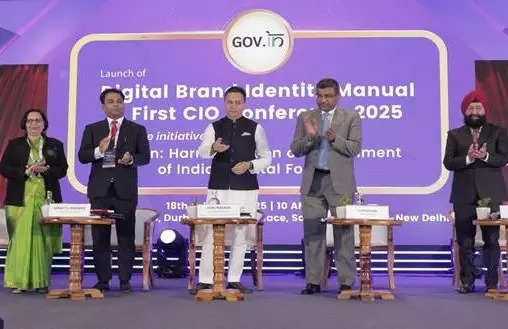
NEW DELHI: The Ministry of Electronics and Information Technology (MeitY) has taken a significant step towards harmonizing India’s digital governance by launching the Digital Brand Identity Manual (DBIM) and hosting the inaugural Chief Information Officer (CIO) Conference 2025 in New Delhi on Tuesday. The event, held under the ‘Gov.In: Harmonisation of Government of India’s Digital Footprint’ initiative, was presided over by Union Minister of State for Electronics and IT, Jitin Prasada, and MeitY Secretary, S. Krishnan. A Cohesive Digital Identity for Government Platforms
At the launch, Jitin Prasada emphasized that the DBIM will reinforce the government’s “Minimum Government, Maximum Governance” approach by fostering “Uniform Governance.” The initiative aims to establish a standardized and cohesive digital identity across all government ministries and platforms, enhancing accessibility, inclusivity, and citizen engagement.
He further highlighted that DBIM aligns with Prime Minister Narendra Modi’s vision of “Reform, Perform, and Transform,” streamlining India’s digital governance and strengthening its e-governance ecosystem at a global level. The manual will simplify and standardize government websites, making essential public services more navigable and user-friendly for citizens from diverse backgrounds.
Additionally, the Central Content Publishing System (CCPS) was introduced as part of the initiative to improve transparency and public engagement by centralizing access to key government policies, schemes, and updates. Prasada also underscored the role of AI-driven tools and robust cybersecurity measures in ensuring a secure, efficient, and future-ready digital governance framework aligned with India’s vision of Viksit Bharat 2047.
Enhancing Service Delivery through DBIM
MeitY Secretary Krishnan reiterated the Prime Minister’s directive for a common digital interface across government websites to ensure a uniform and user-centric experience. He stressed that government portals must match the efficiency and accessibility of private sector platforms, optimizing services for both desktop and mobile users.
To enhance service delivery, the DBIM introduces:
- A standardized toolkit for ensuring a uniform digital identity.
- The Gov.In CMS Platform for streamlined website management.
- A Central Content Publishing System (CCPS) for unified content governance.
- Social Media Campaign Guidelines to standardize government digital communication.
As a live demonstration of the initiative, the event also featured the launch of the DBIM-compliant MeitY website, along with the migration of four other ministry/ department websites to the Gov.In CMS platform, with more expected to follow.
First CIO Conference 2025: Key Takeaways
The first-ever Chief Information Officer (CIO) Conference 2025 brought together experts from MeitY, NIC, MyGov, and various ministries to discuss the adoption and implementation of DBIM. The key topics included:
- Harmonizing government websites under a unified digital brand identity.
- Managing websites on the Gov.In platform to enhance accessibility and performance.
- Localizing content and optimizing digital services for greater inclusivity.
- Ensuring compliance with Guidelines for Indian Government Websites and Apps (GIGW) and STQC Certification for quality assurance.
The nationwide adoption of DBIM is expected to revolutionize citizen engagement, strengthen trust in government services, and enhance India’s digital governance framework.
Towards a Unified Digital Future
As part of the Gov.In initiative, DBIM is a pivotal step towards creating a seamless and standardized digital presence across all government ministries, departments, and agencies. By unifying design elements such as typography, color palettes, and iconography, the initiative ensures consistency, strengthens data integrity, and enhances public trust in government-hosted information.
The guidelines extend beyond government websites to include mobile applications and social media platforms, reinforcing a consistent, modern, and citizen-friendly digital experience.


